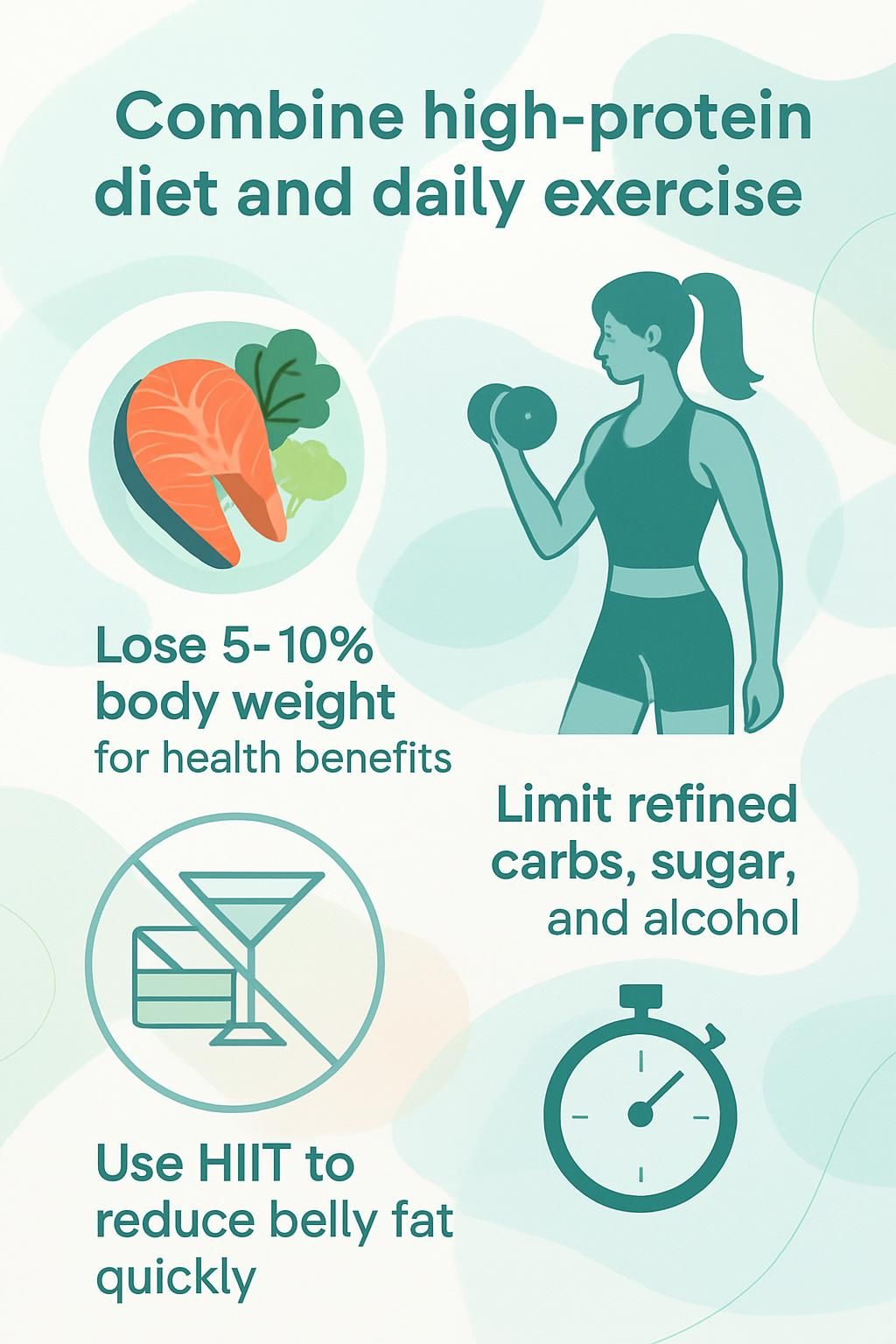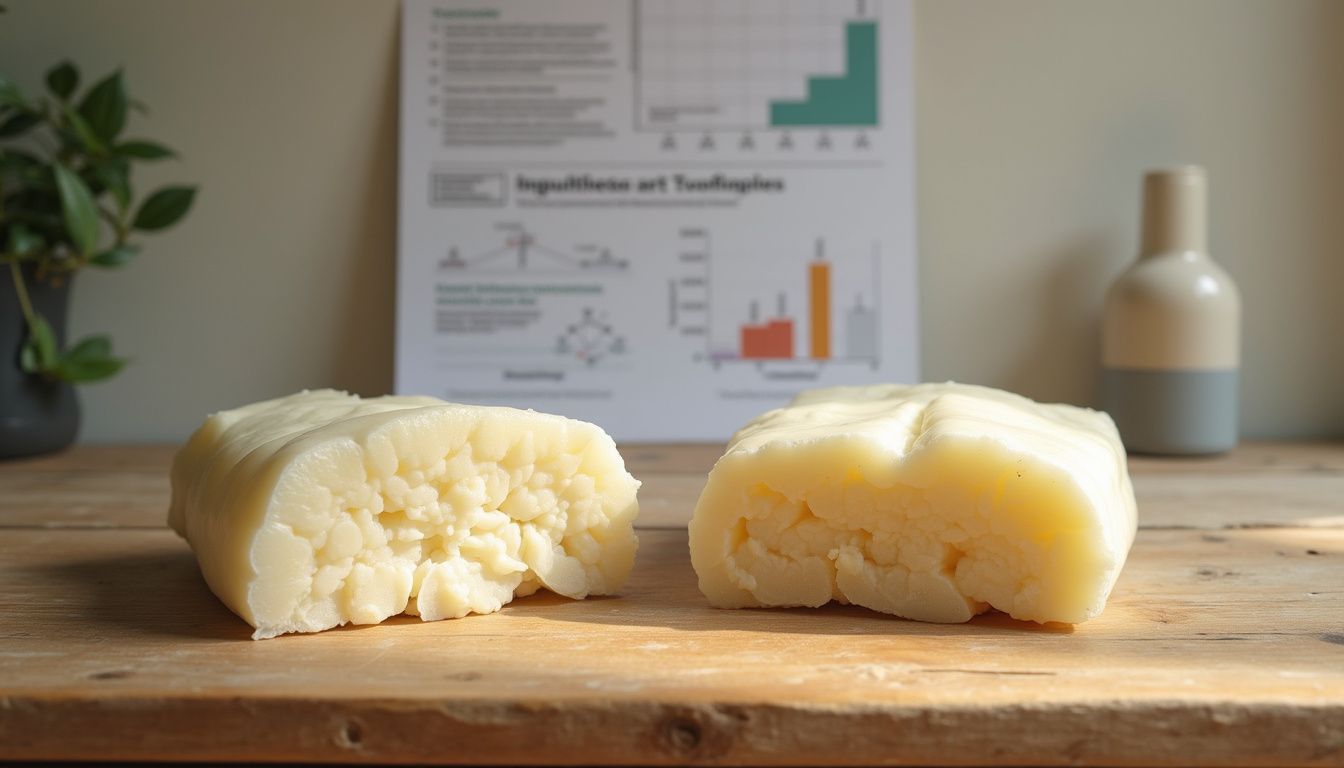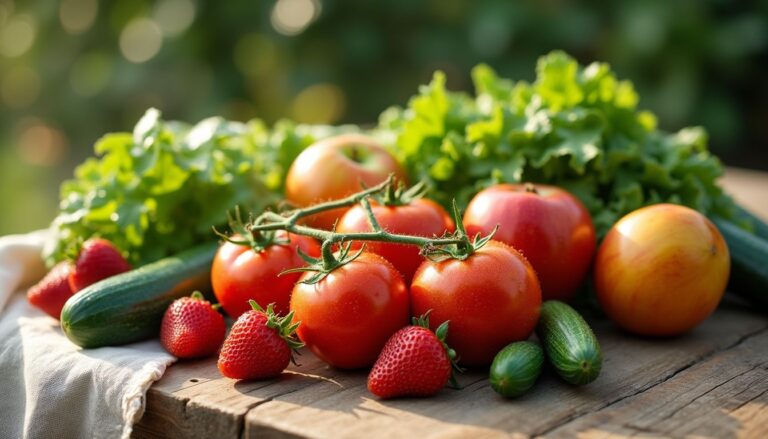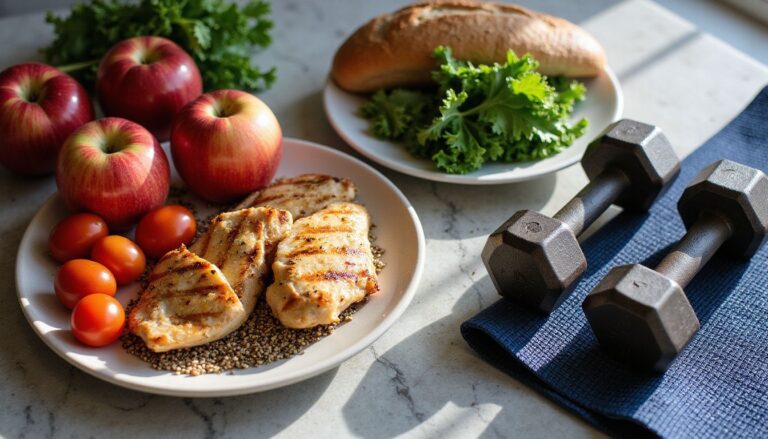Efficient Ways To Lose Belly Fat In A Week: Diet And Exercises For Rapid Fat Loss
Our Nutrition Assistant AI Suite will transform your body. You will lose fat, get toned, and build muscle. Gain confidence and optimal health.
Struggling with stubborn belly fat can feel discouraging, especially when you want fast change. Extra fat around your waist raises the risk of heart disease and type 2 diabetes, so acting now matters. This guide shows how to lose belly fat in one week with smart food choices and focused workouts.
Follow the steps to tighten your waistline safely. You will get practical tips, short workouts, and a simple plan you can start today.
Key Takeaways
- A high-protein, fiber-rich diet plus daily aerobic and resistance exercise can trim belly fat within a week, supported by research from Harvard and the CDC.
- Visceral fat, the fat around your organs, raises the risk of heart disease and type 2 diabetes. Losing 5 to 10 percent of body weight lowers those risks.
- Limiting refined carbs, sugary drinks, processed foods, and alcohol slows fat gain at the waist and supports faster weight loss in clinical studies.
- High-intensity interval training, or HIIT, increases calorie burn after exercise and reduces visceral fat faster than steady cardio, based on Harvard guidance.
- Tracking calories, managing stress, sleeping 7 to 9 hours, and staying hydrated help maintain steady, sustainable fat loss.

Different Types of Belly Fat and Their Health Impact

Belly fat is not one thing. Different types affect your body in different ways. Knowing the difference helps you pick the right plan to cut inches and protect your health.
What Are the Types of Belly Fat: Subcutaneous, Intramuscular, and Visceral?
Your abdomen stores a few kinds of fat. Each one behaves differently and responds to diet and exercise in its own way.
- Subcutaneous fat sits just under the skin. You can pinch it. It is visible and often responds well to a balanced diet and steady exercise.
- Visceral fat wraps around organs like the liver and intestines. It is riskier because it raises the chance of heart disease, type 2 diabetes, and some cancers. Regular cardio, strength training, and nutritious meals help reduce it.
- Intramuscular fat is stored within muscles. Most people carry little here. Consistent activity and protein-rich meals help keep it lower.
- Too much visceral fat can worsen insulin resistance, which pushes the body toward metabolic syndrome. Cardio plus core training supports better metabolic health.
- Subcutaneous fat is less harmful than visceral fat, but too much can impact body composition and confidence. Reducing it reveals a flatter stomach.
- Visceral fat often responds faster to diet changes and aerobic exercise like running or cycling. That is why consistent cardio helps you lose fat faster.
- Diets high in sugar and refined carbs make tummy fat gain more likely. Cutting these foods supports steady belly fat loss.
- Higher protein and more dietary fiber can reduce fat storage. Add fish, eggs, beans, nuts, and leafy vegetables for lasting benefits.
- Tracking your weight, calorie intake, and workouts shows what is working. Seeing progress helps you stay on track.
- Studies show that a healthy diet plus regular activity reduces both visceral and subcutaneous fat over time, lowering the risk of cardiovascular disease.
Why Is It Important to Target Belly Fat for Better Health?
Excess belly fat, especially visceral fat, sits deep in the abdomen and can raise the risk of type 2 diabetes, heart disease, metabolic syndrome, and some cancers. It also drives inflammation and can increase cortisol, a stress hormone that promotes fat storage.
Trimming even 5 to 10 percent of your body weight lowers these risks. Waist-to-hip ratio is a useful check for abdominal obesity, and dropping inches improves that score. Cutting sugary drinks and eating more fiber makes a quick difference, especially when paired with exercises for belly fat.
In short, targeting belly fat supports better metabolism and steadier hormones, which makes further weight loss easier.
How Can Diet Help You Lose Belly Fat in a Week?
Food choices shape your results. A few focused changes can help your body burn fat and shrink your waist in seven days.
How Does Soluble Fiber Help Reduce Belly Fat?
Soluble fiber dissolves in water and forms a gel in the gut, which slows digestion. This helps you feel full longer and reduces total calories. Eating about 10 grams per day is linked with less belly fat over time. Oats, apples, lentils, chia, and broccoli are solid options.
Soluble fiber also feeds good gut bacteria and lowers inflammation, which supports fat loss. A glass of water with fiber-rich meals can improve fullness and nutrient absorption.
Focus on fiber daily to curb snacking and support steady fat loss around your waist.
Why Should You Eat High-Protein Meals?
Protein protects muscle while you lose weight and helps control hunger. It also has a higher thermic effect, meaning your body uses more calories to digest it than it does for fats or carbs. Lean meats, fish, eggs, Greek yogurt, tofu, and beans are top picks.
Raising protein to roughly 25 to 30 percent of daily calories can cut hunger and reduce late-night snacking. A protein-rich breakfast or lunch sets a strong tone for the rest of your day.
What Are Healthy Fats and How Do They Aid Fat Loss?
Healthy fats, such as those in olive oil, avocados, nuts, seeds, and fatty fish, help keep you full and support heart health. Replacing butter or margarine with extra-virgin olive oil is one simple swap.
Your body uses these fats to absorb vitamins and support hormones involved in fat burning. Getting 20 to 35 percent of calories from mostly unsaturated fats fits well with many weight-loss plans.
Controlled trials link monounsaturated and polyunsaturated fats with lower visceral fat compared with saturated or trans fats.[1] A quick example, swap creamy salad dressing for lemon juice and olive oil to cut calories and cravings.
[1] Jensen MD et al., “Effects of Dietary Fatty Acids on Plasma Markers of Inflammation in Healthy Humans: The LIPGENE Study,” American Journal of Clinical Nutrition (2017).
Which Sugary and Processed Foods Should You Avoid?
Sugary and ultra-processed foods add fast calories and push belly fat gain. Limit the items below to speed results.
- Sweetened drinks like soda, energy drinks, and sweet tea add liquid sugar that drives fat storage at the waist.
- Desserts and pastries spike blood sugar and deliver excess calories that go straight to storage.
- Convenience snacks such as chips or packaged meals often hide sugar, salt, and low-quality fats.
- Sweet breakfast cereals can be as sugary as dessert and make cravings worse by midmorning.
- Processed meats like bacon and sausage come with added salt and fats that do not support fat loss.
- Refined grains such as white bread and crackers lack fiber and lead to blood sugar swings.
- Fruit drinks that are not 100 percent juice deliver sugar without fiber or key nutrients.
- Alcohol, especially sweet cocktails and heavy beer, adds calories and slows fat burning.
- “Diet” foods labeled low-fat often add sugar to boost taste, which can fuel hunger later.
- Ice cream and sweet yogurts pack many teaspoons of sugar per serving and increase cravings.
How Does Limiting Refined Carbohydrates Support Fat Loss?
Refined carbs digest fast and cause insulin spikes. High insulin signals your body to store fat, especially around the belly. Swapping white bread, pastries, and sugary drinks for whole grains, vegetables, and beans keeps energy steady.
Research in the New England Journal of Medicine links whole grains with greater loss of abdominal fat over 12 weeks. Many people notice fewer cravings after cutting soda and refined snacks.
Why Is Staying Hydrated and Drinking Green Tea Beneficial?
Water supports metabolism and reduces water retention. Drinking a cup before meals can lower calorie intake. Better hydration also improves energy for workouts.
Green tea contains catechins, antioxidants tied to reduced belly fat in several studies. Two to three cups per day may support fat burning and reduce bloating.
What Is Intermittent Fasting and How Does It Help Lose Belly Fat?
Intermittent fasting limits eating to set hours, for example a 16-hour fast with an 8-hour eating window. During fasting, insulin drops and the body is more likely to use stored fat for fuel. Many people also eat fewer calories without tracking every bite.
Studies link intermittent fasting with smaller waists and lower visceral fat. If you take medication, are pregnant, or have a medical condition, speak with a healthcare professional before starting.
Effective Exercises for Rapid Belly Fat Loss
Exercise turns your body into a steady calorie burner. Short, focused sessions can make a big difference in a week.
What Are the Benefits of Aerobic Exercises Like Running, Cycling, and Swimming?
Aerobic exercise raises your heart rate and uses large muscles. That combination burns many calories and targets visceral fat. Aim for at least 150 minutes per week.
Running and cycling improve your heart and lungs. Swimming is easier on the joints and challenges your legs, core, and upper body.
Regular cardio also boosts sleep quality and reduces stress, both helpful for fat loss.
How Does High-Intensity Interval Training (HIIT) Burn Belly Fat?
HIIT uses short bursts of near-max effort followed by brief recovery. This approach can raise metabolism for hours after the workout. Sessions are efficient and can fit into busy days.
A simple example, sprint 30 seconds, then walk 90 seconds, repeat for 10 to 15 minutes. Many people report better energy and endurance after one week of consistent HIIT paired with a solid diet.
[1] Harvard T.H. Chan School of Public Health. “The truth behind the most popular diet trends of the moment.” (2020).
Which Core-Strengthening Workouts Help Reduce Belly Fat?
Strong core muscles support posture and make your waist look tighter. Add two or three of these moves to your routine.
- Planks: hold 30 to 60 seconds, repeat 3 times.
- Bicycle crunches: 3 sets of 15 to 20 reps.
- Russian twists: use a light weight for 15 to 20 reps per set.
- Leg raises: 3 sets of 12 to 15 reps with slow control.
- Mountain climbers: 3 rounds of 30 seconds to raise heart rate.
- Flutter kicks: 2 to 3 sets of 30 to 60 seconds.
- Dead bugs: 2 sets of 10 reps per side with core braced.
Pair core work with walking or cycling for even better fat loss around the waist.
How Does Resistance Training Support Belly Fat Loss?
Resistance training builds muscle, which raises resting metabolism. That means you burn more calories even while sitting. People who combine strength work with cardio tend to lose more belly fat than those who skip it.
Do squats, lunges, rows, and push-ups two or three days per week. Strength sessions also help regulate stress hormones that affect fat storage.
Can Speed Walking and Jumping Rope Help Lose Belly Fat?
Speed walking lifts your heart rate and burns steady calories. The CDC recommends at least 150 minutes of brisk walking per week for weight control and better heart health.
Jumping rope trains your core, arms, and legs at the same time. In about 15 minutes, many people can burn up to 200 calories. Rotating brisk walks with jump rope can accelerate waistline changes.
These activities also improve blood sugar control, which helps prevent insulin resistance, a driver of belly fat gain.
Lifestyle Changes That Promote Sustainable Fat Loss
Small daily habits compound quickly. Tweak stress, sleep, and tracking to support lasting change.
How Can Reducing Stress Levels Help With Fat Loss?
High stress raises cortisol, a hormone that can push fat toward the belly. It can also trigger cravings for sweet, high-calorie foods.
Short, simple tools help. Try deep breathing, a 10-minute walk, gentle yoga, or a short meditation. As stress eases, appetite control usually improves and sleep often gets better.
Why Is Getting Plenty of Restful Sleep Important for Losing Belly Fat?
Sleep controls two key hunger hormones. Ghrelin rises when you are short on sleep and makes you hungry. Leptin falls and makes it harder to feel full.
Adults who sleep less than seven hours more often gain weight at the waist. Aim for 7 to 9 hours per night. Limit caffeine and alcohol in the evening to protect sleep quality.
How Does Tracking Calorie Intake and Activity Aid Fat Loss?
Tracking shows the facts. Apps or food logs help you see how many calories you eat. Fitness trackers estimate steps and activity calories.
With real numbers, it is easier to keep a small calorie deficit, avoid plateaus, and adjust quickly. Many people lose more weight when they track consistently.
What Is the Impact of Limiting Alcohol Consumption on Belly Fat?
Alcohol adds extra calories and can slow fat burning. Cutting back often reduces waist size, especially from visceral fat near the organs.
Swapping cocktails for water, seltzer, or herbal tea supports sleep, workouts, and appetite control. Many people notice fewer cravings within a couple of weeks.
7-Day Meal Plan for Rapid Belly Fat Loss
A simple weekly plan removes guesswork. Use these ideas as a template and adjust portions to your needs.
What to Eat on Day 1: High-Protein Breakfast, Light Lunch, and Fiber-Rich Dinner
Start with a high-protein breakfast such as eggs, Greek yogurt, or a protein smoothie. Protein curbs hunger and supports muscle. For lunch, choose a light plate like grilled chicken over greens with tomatoes and cucumbers.
Make dinner fiber-rich, for example a vegetable stir-fry with lentils or chickpeas served over quinoa. Fiber improves fullness and digestion.[1] Drink water or green tea with meals.
[1] Harvard T.H. Chan School of Public Health, The Nutrition Source, Fiber.
What to Eat on Day 2: Balanced Meals with Healthy Fats and Vegetables
Cook eggs in olive oil and add spinach and avocado at breakfast. For lunch, try grilled salmon on mixed greens with an olive oil vinaigrette. Snack on a small handful of almonds or walnuts.
At dinner, pair roasted chicken with steamed broccoli and carrots tossed in a bit of sesame or olive oil. Unsaturated fats help regulate hunger hormones and may trim abdominal fat over time.
What to Eat on Day 3: Incorporate Probiotic-Rich Foods
Add yogurt with live cultures or kefir to breakfast or a snack. Include sauerkraut or kimchi with lunch or dinner. Probiotics support a healthy gut, lower inflammation, and may help reduce belly fat in controlled studies.
Pair probiotics with prebiotic fiber like oats or bananas to feed beneficial bacteria.
What to Eat on Day 4: Low-Carb, High-Fiber Meals
Focus on non-starchy vegetables such as broccoli, cauliflower rice, and leafy greens. Top salads with grilled turkey or salmon for protein. Mix chia or flaxseed into Greek yogurt for extra soluble fiber.
For lunch, try zucchini noodles with ground turkey and tomato sauce. Snack on cut vegetables. Research suggests 25 to 30 grams of fiber per day supports weight loss and fullness.
What to Eat on Day 5: Focus on Lean Proteins and Healthy Snacks
Choose lean proteins like chicken breast, white fish, tofu, or cottage cheese. Add colorful vegetables to each meal. Keep snacks simple and nutrient-dense, for example Greek yogurt, hummus with cucumbers, or a small portion of nuts.
Preparing meals ahead reduces the urge to grab high-sugar, high-fat snacks later.
What to Eat on Day 6: Hydrating Drinks and Whole Foods
Begin with water or unsweetened tea, such as green tea. Add water-rich fruits and vegetables like watermelon, oranges, and cucumbers throughout the day. Aim for at least eight cups of fluid, more if you are active.
Build meals around whole foods, including leafy greens, peppers, carrots, brown rice or quinoa, and lean protein like baked salmon or tofu.
What to Eat on Day 7: A Light Diet with Green Tea
Keep meals easy to digest. Oatmeal, steamed vegetables, clear soups, and small portions of lean protein work well. Snack on berries or a sliced apple. Continue drinking water.
Have a cup of green tea in the morning and another in the afternoon. The catechins in green tea may support fat burning during activity.
Common Mistakes to Avoid When Losing Belly Fat
A few traps can slow your progress. Fixing them often speeds results within days.
Why Is Skipping Meals a Mistake?
Skipping meals can slow metabolism and trigger overeating later. People who skip breakfast have higher rates of heart disease and often struggle with cravings.
I tried skipping lunch for a week and felt tired and irritable by dinner, which led to overeating. Regular, balanced meals provide steady fuel for calorie burning and help protect lean muscle.
Summary Table: Effects of Skipping Meals
| Effect | Impact on Belly Fat |
|---|---|
| Slower metabolism | Promotes fat storage |
| Overeating later | Raises daily calories |
| Low energy | Hurts workout quality |
| Poor food choices | More processed snacks |
How Can Overeating “Healthy” Foods Hinder Fat Loss?
Even healthy foods add up. Nuts, oils, avocados, and whole grains are nutritious but calorie-dense. A cup of almonds tops 500 calories, and two tablespoons of peanut butter are close to 200.
Watch portions and track intake so nutrient-rich foods support, not stall, fat loss.
Why Is Exercise Consistency Important?
Consistency beats intensity. People who exercise at least four days per week tend to reduce abdominal fat more than those who work out less often. Regular activity supports muscle tone, energy, and better eating decisions.
Create a weekly schedule and treat workouts like appointments. Small, steady sessions win.
Frequently Asked Questions About Losing Belly Fat
Here are quick, evidence-based answers to common questions.
What Exercises Burn the Most Belly Fat?
HIIT is one of the most efficient options for rapid fat loss. It alternates hard efforts with short rests to keep calorie burn high during and after the workout. Aerobic exercise like running, cycling, and swimming also targets visceral fat.
Short on time? Try brisk walking or jump rope for 30 minutes a day. Paired with a healthy diet and hydration, these activities can shrink waist size within a week.
Can You Lose Belly Fat Without Exercise?
Yes. A calorie deficit from diet alone can reduce belly fat. Cutting about 500 calories per day often leads to a pound of weight loss per week.
Build meals around vegetables, lean proteins, and fiber. Limit refined carbs and sugary drinks. Some people find intermittent fasting helpful for managing calories without formal workouts.
What Are the Best Foods for Rapid Belly Fat Loss?
Choose foods that keep you full, support muscle, and steady blood sugar.
- Eggs: high-quality protein that reduces hunger later in the day.
- Oats: rich in soluble fiber for fullness and better blood sugar control.
- Leafy greens: low-calorie, high-fiber vegetables like spinach and kale.
- Fatty fish: salmon or tuna for omega-3 fats that support heart health.
- Greek yogurt: protein plus probiotics for gut support.
- Berries: fiber and antioxidants to help manage cravings.
- Avocados: healthy fats that increase satisfaction.
- Green tea: catechins that may boost fat burning.
- Nuts: a small handful curbs hunger, watch portions.
- Beans and lentils: fiber and plant protein for steady energy.
- Water-rich vegetables: cucumbers and celery for volume with few calories.
Conclusion
Rapid change starts with simple habits. Eat more fiber, protein, and healthy fats. Pair that healthy diet with daily aerobic exercise and two or three strength sessions to help reduce belly fat faster.
Track your meals and activity, sleep 7 to 9 hours, and lower stress. Green tea, smart hydration, and fewer sugary foods can also help. This article is educational and not medical advice. If you have a condition or take medication, speak with a healthcare professional before making big changes.
Stay consistent for a week to see progress at your waistline, then keep going for even better health.
FAQs
1. What are the most efficient diet changes to lose belly fat in a week?
Reducing added sugars, increasing lean protein intake, and eating more vegetables can help reduce abdominal fat quickly. Studies show that diets high in fiber and low in refined carbohydrates support rapid fat loss.
2. Which exercises target belly fat most effectively for fast results?
High-intensity interval training (HIIT), brisk walking, and core-strengthening movements like planks or bicycle crunches burn calories and improve muscle tone around the waistline. Research indicates HIIT may lead to greater short-term reductions in body fat compared to moderate exercise.
3. Is it possible to see visible changes in belly size within one week using these methods?
Some people notice less bloating and a slimmer appearance after seven days of consistent healthy eating and regular exercise; however, significant long-term fat loss requires ongoing effort beyond one week.
4. How does personal experience with rapid weight loss inform best practices?
After following a structured meal plan focused on whole foods while adding daily HIIT sessions for one week, I observed reduced waist measurements and improved energy levels. This approach aligns with evidence-based recommendations for safe, effective short-term fat reduction.
Summary: Rapid belly fat loss involves dietary adjustments such as reducing sugar intake, choosing lean proteins, and consuming more vegetables along with targeted physical activity like HIIT or core exercises. While some individuals may see quick improvements in bloating or waist size within a week, lasting results depend on continued healthy habits supported by scientific research.







